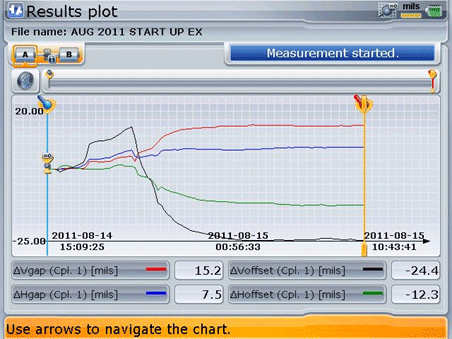In the previous article, we discussed two methods for thermal growth monitoring, the “snapshot method” and “continuous monitoring”. With the “snapshot” method, we only knew the initial and final thermal growth readings, with no information in between. Some typical “snapshot” results are shown below:
Vertical Offset: -24.4 mils
Vertical Angularity: 15.2 mils/10″
Horizontal Offset: -12.3 mils
Horizontal Angularity: 7.5 mils
“Continuous monitoring” is exactly what it says: the thermal growth is “continuously monitored”. Our ROTALIGN® ULTRA LIVE TREND and PERMALIGN® thermal growth monitoring systems work in this way.
Alignment readings between the machines are taken at preset intervals for a predetermined amount of time. The relative alignment changes are then clearly displayed as a set of graphs. Here are the same “snapshot” readings, but this time displayed as a continuously monitored measurement from the ROTALIGN ULTRA LIVE TREND.

Notice the chart displays the same final “snapshot” alignment readings, but this time we see the graphs of all the positional changes that occurred along the way, from the starting to the ending position, which are not readily apparent with the simple “snapshot” method. These graphs reveal the following:
- The vertical offset had moved in the positive direction and then changed to the opposite direction.
- The readings stabilized in the last 40% of the measurement. This shows us that the final readings were taken when the machine had stabilized.
- There are no sharp drops or radical moves. We are assured the bracket was not bumped or hit during measurement.
- The readings were consistent, indicating that vibration was not severely influencing the results (which can be compensated for by simply increasing the number of points taken per measurement at each interval).
It is essential to get dependable and reliable results for thermal growth studies because you will be deliberately misaligning a machine for the purpose of improving the alignment. Individual events during the monitoring period can be tagged and commented upon, thereby allowing the effects of external actions (such as opening or closing a valve, changing the load on the machines, or starting a nearby machine, say) to be documented. The extra information gathered by continuous monitoring is very useful for thermal growth monitoring. Continuous monitoring provides essential evidence for the user to confidently state, “it is what it is”, with regards to misalignment due to thermal growth.
In Part 3 of this article, we will discuss how to choose a thermal growth monitoring system.
Filed under:
Alignment by Daus Studenberg CRL
